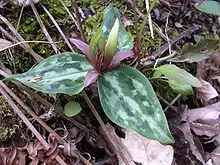Trillium reliquum
Trillium reliquum, the relict trillium,[1] Confederate wakerobin,[2] or Confederate trillium, is a monocotyledon species of the genus Trillium, a perennial, flowering, herbaceous plant of the family Liliaceae. It is found only in the southeastern region of the United States: southwest, central and east central Alabama, Georgia, South Carolina and Tennessee. As a relict species, there are a few remaining groups but it was once more abundant when conditions were different. Significant habitat loss has occurred through clearing of forests for agricultural and pine farm uses.[3]
| Trillium reliquum | |
|---|---|
 | |
| Trillium reliquum demonstrating its three mottled elliptical, pointed leaves | |
| Scientific classification | |
| Kingdom: | Plantae |
| Clade: | Tracheophytes |
| Clade: | Angiosperms |
| Clade: | Monocots |
| Order: | Liliales |
| Family: | Melanthiaceae |
| Genus: | Trillium |
| Species: | T. reliquum |
| Binomial name | |
| Trillium reliquum J. D. Freeman, 1975 | |
On April 4, 1988, it was officially listed as an endangered species.[4] The common name varies by location.[5] It grows in undisturbed hardwood forests that sometimes include mature pines and that are free of understory plants such as bushes and vines. It likes moist, well-drained soils along the banks of streams and small stream floodplains, mixed with other wildflowers and forest debris.[6]
Trillium reliquum was first collected near Augusta in 1901 but was not described as a new species until 1975.[3] In February 2010, hikers found the plant at the Lake Jackson Mounds Archaeological State Park in the Florida Panhandle. The US Fish and Wildlife Service is surveying the plants.
Flower
Trillium reliquum has a sessile flower on a curved stem at the center of its three mottled leaves that are blue-green, to green to silver in color. It flowers from March to April.[3] From the end of a stocky underground rhizome, the plant sprouts a single shoot topped by the three mottled leaves and a single sessile flower; the flower is only half the size of the leaves. The stem is normally not erect, but rather lies along the ground. The flower consists of three petals, alternating with three sepals.[7] The flowers can be greenish to brownish-purple and even pure yellow at times. Its three sepals spread out and usually are a purple color on the inside. The three petals tend to be erect and somewhat twisted, varying from dark purple to yellow in color. The petals are about twice as long as the stamens.[8] The fruit, which is a round, fleshy capsule, appears from May to June.
Future
The U.S. Fish & Wildlife Service lists this plant as surviving in 21 sites in Alabama, Georgia and South Carolina.[7] The relict trillium has also been found in Tennessee and Florida. The reasons for the restrictions of this formerly widespread plant to only a few locations is not entirely clear. It is not commonly collected in the wild (for aesthetic or other uses) and is therefore considered relatively safe, in spite of its endangerment. There is no evidence that its numbers have declined recently.[7]
References
- Case Jr., Frederick W. (2002). "Trillium reliquum". In Flora of North America Editorial Committee (ed.). Flora of North America North of Mexico (FNA). 26. New York and Oxford. Retrieved July 16, 2019 – via eFloras.org, Missouri Botanical Garden, St. Louis, MO & Harvard University Herbaria, Cambridge, MA.
- "Trillium reliquum". Natural Resources Conservation Service PLANTS Database. USDA. Retrieved 15 December 2015.
- Georgia Department of Natural Resources. "trillium reliquum Freeman" (PDF). www.georgiawildlife.org. Retrieved November 15, 2009.
- "Species Profile for Relict trillium (Trillium reliquum)". ecos.fws.gov. Retrieved November 15, 2009.
- "Profile for Trillium reliquum (Confederate wakerobin)". USDA PLANTS. Retrieved November 15, 2009.
- "Endangered Species - Species ID". www.sas.usace.army.mil. Archived from the original on January 14, 2009. Retrieved November 15, 2009.
- Rumsey, Frank (2001). Endangered Wildlife and Plants of the World. Marshall Cavendish Corporation. p. 1540. ISBN 9780761471943.
- "Relict Trillium (Trillium reliquum) Species Profile". www.goldendelighthoney.com. Retrieved November 15, 2009.
External links
- Citizen science observations for Trillium reliquum at iNaturalist
- "Developer Rescues Endangered Trillium". www.southeasternoutdoors.com. Retrieved November 15, 2009.
- "Trillium reliquum - Fact Sheet - Relict Trillium". utc.usu.edu. Archived from the original on May 20, 2007. Retrieved November 15, 2009.
- "Celebrating Wildflowers - TEP Plant Profile - Trillium reliquum, relict trillium". www.fs.fed.us. Retrieved November 15, 2009.
- Recovery plan for trillium reliquum U.S. Fish & Wildlife Service. (PDF) Retrieved November 16, 2009
- "Recovery Plan Action Status". ecos.fws.gov. Retrieved November 16, 2009.

